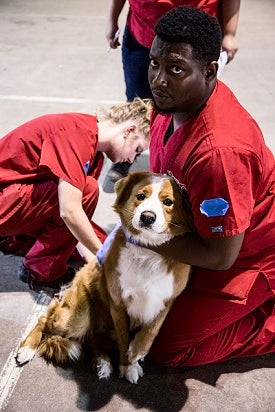
Getting a handle on viral outbreaks in your dog populations
May 16, 2023
In a January 2023 editorial, Best Friends medical director Erin Katribe, DVM, talked about how to prevent and manage distemper, parvovirus, and canine influenza in shelter environments. She included a lot of vital information in the piece, and here is a summary of the high points followed by links to other resources to help your shelter or rescue keep dogs healthy while they are in your care.
First, it’s important to know the difference between these viruses – their symptoms, how they are spread, and how they respond to treatment:
Distemper
- Affects the respiratory tract, causing cough, nasal discharge, and conjunctivitis. Approximately 10% develop neurological signs, sometimes severe enough to warrant euthanasia.
- Transmitted primarily in respiratory secretions, but can pass to other dogs via urine, vomit, or feces. Virus also survives long enough at room temperature (a few hours) to create infection risk via fomites (hard surfaces, clothing).
- Clinical signs typically appear 10-14 days post-exposure, though they may take longer to develop.
- Survival rates are high in adults who receive treatment; puppies are likely to be affected more severely with higher mortality rates.
Parvovirus

- More common in puppies and young dogs, though it can occur in adults.
- Virus attacks GI tract and bone marrow, weakening the immune system and compromising the intestinal lining. Dogs may develop systemic infection or fatal sepsis due to normal GI bacteria passing into the bloodstream.
- Spread through direct contact with fecal matter from sick dogs and via fomites (parvovirus can live in the environment for months without proper disinfection).
- Symptoms are vomiting, diarrhea, and decreased appetite.
- Clinical signs appear 7-10 days after exposure; dogs are contagious before symptoms appear.
- High risk of death in puppies without treatment; with treatment, survival rates can be 90% or greater.
Canine influenza
- Affects both puppies and adults.
- Spread through direct contact between infected dogs, airborne, fomites.
- Affects the respiratory tract, causing symptoms such as coughing and sneezing.
- Though it rarely causes severe disease, canine influenza can progress to pneumonia, especially when other respiratory viral or bacterial infections are present (coinfections are common in shelters).
- Clinical signs typically appear in a week or less.
- Much shorter-lived in the environment than parvo.
 Preventative measures – vaccination
Preventative measures – vaccination
- Vaccinate for distemper and parvovirus upon or prior to intake.
- Puppies in particular must be vaccinated early and often (see puppy vaccine protocols).
- Influenza vaccine does not provide a significant degree of protection until after the second dose.
- As most dogs do not remain in the shelter that long, the vaccine is not routinely recommended in such settings.
- Use modified live vaccines whenever possible and mix vaccines according to instructions. Erin notes:
- Some shelters “want to be efficient and mix up all of the distemper/parvo combo vaccines each morning for their anticipated intake that day. Unfortunately, those vaccines are no longer good within 30 minutes to an hour of mixing them up. It's no better than injecting water into those dogs.”
Preventative measures – sanitation and disinfection
- Not all disinfectants are effective against the more stable viruses (parvovirus, panleukopenia, calicivirus) despite what label says.
- There are great resources online about which disinfectants are effective for which pathogens; we also have created a playbook on this topic.
- Dilute products appropriately and allow them to sit for the full contact time (5-10 minutes depending on product and concentration).
- Use caution when handling animals, especially those at highest risk (puppies and kittens). Wear gloves and gowns or wrap the animal in a blanket. They are at risk of contracting a contagious disease and pose a risk in that they are more likely to be contagious and can contaminate staff/equipment.
Preventative measures – isolation
- Isolate symptomatic animals immediately.
- Separate populations into groups based on signs of disease and according to testing status if available (e.g., confirmed negative, results pending, confirmed positive).
- Pursue foster options. Distemper and parvo positive dogs can be fostered in homes with adult dogs who are fully vaccinated. Other contagious dogs may be able to go to foster in homes without other dogs or where resident dogs are kept separate.
- Implement limited admission/emergency-only policy whenever possible. Though many shelters think they can’t turn animals away, Erin points out that it’s better to be cautious:
- “I oftentimes hear, ‘Well, we're an open intake shelter. We have these contracts, so we have to take in dogs.’ If you don't have a way to separate new intakes, it's irresponsible to continue to take in animals at the same level and expose them to potentially fatal infectious diseases. And turning any dog away in such circumstances requires full transparency. Shelters must be honest with the public and contract-holders and say, ‘We do not have a way to safely take these animals; we are putting them at risk if we accept them.’
Treatment

- Viruses must run their course. Provide supportive care (e.g., fluid therapy, anti-nausea medication) and antibiotics for secondary bacterial infections.
- Dogs with respiratory viral infections may benefit from antibiotics for co-infections and to reduce the chances of developing bacterial pneumonia. If severe pneumonia develops (rare), oxygen therapy may be required.
- Neurological signs related to distemper may require treatment depending on severity. Neurological signs with distemper vary from mild, intermittent muscle twitches to severe, long-lasting seizures that may not respond to anticonvulsants.
When to consider euthanasia
- To alleviate suffering when diseases are severe and unmanageable.
- In distemper cases where shelters lack a safe place to hold sick dogs (including in foster).
- In parvo puppies who have overwhelming sepsis that does not respond to treatment.
- Erin never advocates for euthanizing all animals in the shelter when some are sick:
- “Unfortunately, there will often be the need to make some euthanasia decisions. While that is really hard, it's not a wrong decision when we think about risking the rest of the population. I learned in vet school … that distemper is a death sentence, so if we saw it, we should just euthanize immediately. That’s also absolutely not the case. Many adult dogs (and some puppies) will only get distemper symptoms similar in severity to those in your run-of-the-mill kennel cough; as long as we can hang on to them safely without risking the rest of the population, then why wouldn’t we try to save them? … Even if you can't save all the positive dogs, can you save at least some of them? That’s where progress starts.”
Final words of advice
Shelters and rescues should absolutely be transparent with the public about what’s going on behind closed doors and ask for help. Erin advises many organizations to invite volunteers and public into the shelter, because when they see that these diseases are not scary, they will likely be open to fostering such dogs. There’s also no reason to go it alone. Ask for help from experts.
“Managing an outbreak can be really daunting and scary and every outbreak is different,” Erin says. “[Helping is] … part of what I do in my role, and many shelter medicine academic programs do so as well. … Managing an outbreak is very different than managing an individual case of disease, and so finding someone with additional training in shelter medicine is crucial.”
Here are some additional resources to help your organization respond to outbreaks:
Playbooks
Disease control: The role of sanitation training
Infectious disease outbreak response
Other resources
Media strategy a critical part of response to disease outbreaks program spotlight
Puppy protocol: Puppy admission illness prevention
Cleaning and sanitation (online course)
Disease transmission and prevention webinar

Liz Finch
Senior Writer
Best Friends Network
If you enjoyed this program spotlight, you can find our complete catalog of spotlights here.